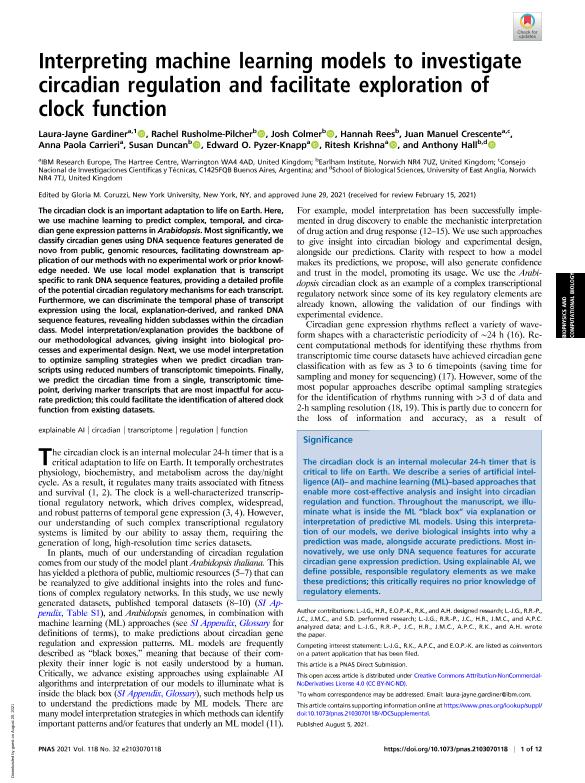Mostrar el registro sencillo del ítem
dc.contributor.author
Gardiner, Laura Jayne
dc.contributor.author
Rusholme Pilcher, Rachel
dc.contributor.author
Colmer, Josh
dc.contributor.author
Rees, Hannah
dc.contributor.author
Crescente, Juan Manuel

dc.contributor.author
Carrieri, Anna Paola
dc.contributor.author
Duncan, Susan
dc.contributor.author
Pyzer-Knapp, Edward O.
dc.contributor.author
Krishna, Ritesh
dc.contributor.author
Hall, Anthony
dc.date.available
2022-02-02T20:54:32Z
dc.date.issued
2021-08
dc.identifier.citation
Gardiner, Laura Jayne; Rusholme Pilcher, Rachel; Colmer, Josh; Rees, Hannah; Crescente, Juan Manuel; et al.; Interpreting machine learning models to investigate circadian regulation and facilitate exploration of clock function; National Academy of Sciences; Proceedings of the National Academy of Sciences of The United States of America; 118; 32; 8-2021; 1-12
dc.identifier.issn
0027-8424
dc.identifier.uri
http://hdl.handle.net/11336/151197
dc.description.abstract
The circadian clock is an important adaptation to life on Earth. Here, we use machine learning to predict complex, temporal, and circadian gene expression patterns in Arabidopsis. Most significantly, we classify circadian genes using DNA sequence features generated de novo from public, genomic resources, facilitating downstream application of our methodswith no experimental work or prior knowledge needed. We use local model explanation that is transcript specific to rank DNA sequence features, providing a detailed profile of the potential circadian regulatory mechanisms for each transcript. Furthermore, we can discriminate the temporal phase of transcript expression using the local, explanation-derived, and ranked DNA sequence features, revealing hidden subclasses within the circadian class. Model interpretation/explanation provides the backbone of our methodological advances, giving insight into biological processes and experimental design. Next, we use model interpretation to optimize sampling strategies when we predict circadian transcripts using reduced numbers of transcriptomic timepoints. Finally, we predict the circadian time from a single, transcriptomic timepoint, deriving marker transcripts that are most impactful for accurate prediction; this could facilitate the identification of altered clock function from existing datasets.
dc.format
application/pdf
dc.language.iso
eng
dc.publisher
National Academy of Sciences

dc.rights
info:eu-repo/semantics/openAccess
dc.rights.uri
https://creativecommons.org/licenses/by-nc-nd/2.5/ar/
dc.subject
CIRCADIAN
dc.subject
EXPLAINABLE AI
dc.subject
FUNCTION
dc.subject
REGULATION
dc.subject
TRANSCRIPTOME
dc.subject.classification
Ciencias de la Información y Bioinformática

dc.subject.classification
Ciencias de la Computación e Información

dc.subject.classification
CIENCIAS NATURALES Y EXACTAS

dc.title
Interpreting machine learning models to investigate circadian regulation and facilitate exploration of clock function
dc.type
info:eu-repo/semantics/article
dc.type
info:ar-repo/semantics/artículo
dc.type
info:eu-repo/semantics/publishedVersion
dc.date.updated
2022-01-25T14:37:04Z
dc.identifier.eissn
1091-6490
dc.journal.volume
118
dc.journal.number
32
dc.journal.pagination
1-12
dc.journal.pais
Estados Unidos

dc.journal.ciudad
Washington D. C.
dc.description.fil
Fil: Gardiner, Laura Jayne. Ibm Research; Estados Unidos
dc.description.fil
Fil: Rusholme Pilcher, Rachel. Earlham Institute; Reino Unido
dc.description.fil
Fil: Colmer, Josh. Earlham Institute; Reino Unido
dc.description.fil
Fil: Rees, Hannah. Earlham Institute; Reino Unido
dc.description.fil
Fil: Crescente, Juan Manuel. Consejo Nacional de Investigaciones Científicas y Técnicas. Centro Científico Tecnológico Conicet - Córdoba; Argentina. Instituto Nacional de Tecnología Agropecuaria. Centro Regional Córdoba. Estación Experimental Agropecuaria Marcos Juárez; Argentina
dc.description.fil
Fil: Carrieri, Anna Paola. Ibm Research; Estados Unidos
dc.description.fil
Fil: Duncan, Susan. Earlham Institute; Reino Unido
dc.description.fil
Fil: Pyzer-Knapp, Edward O.. Ibm Research; Estados Unidos
dc.description.fil
Fil: Krishna, Ritesh. Ibm Research; Estados Unidos
dc.description.fil
Fil: Hall, Anthony. Earlham Institute; Reino Unido. University of East Anglia; Reino Unido
dc.journal.title
Proceedings of the National Academy of Sciences of The United States of America

dc.relation.alternativeid
info:eu-repo/semantics/altIdentifier/url/http://www.pnas.org/lookup/doi/10.1073/pnas.2103070118
dc.relation.alternativeid
info:eu-repo/semantics/altIdentifier/doi/http://dx.doi.org/10.1073/pnas.2103070118
Archivos asociados
